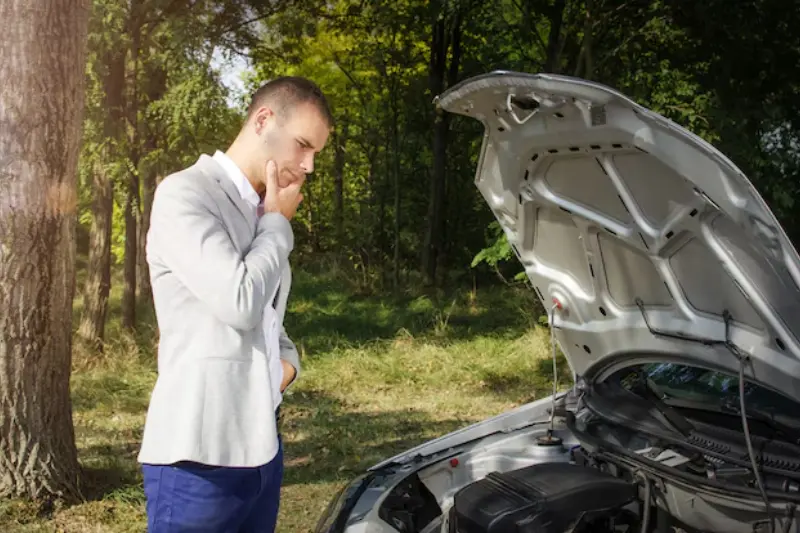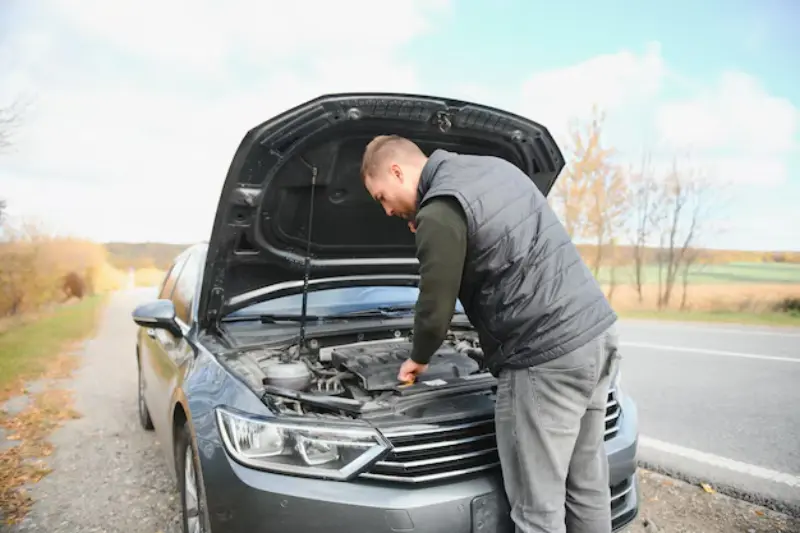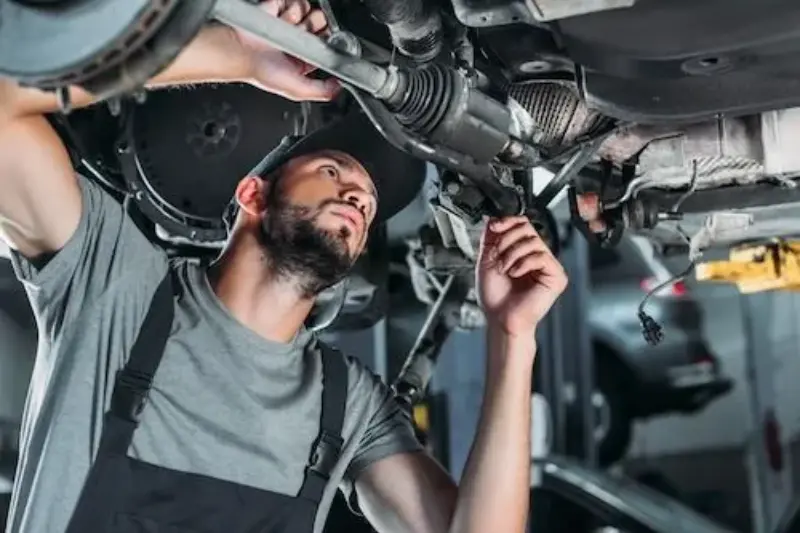Introduction
Have you ever been in a situation where your car suddenly stopped working, and you had no idea what to do next? Don’t worry—you’re not alone. “How to fix a broken car” Cars can break down for many reasons, and it can be confusing (and stressful) when it happens.
In this blog post, we’ll explain in simple words what it means when a car is “broken” and how you can fix it. Whether your car won’t start, makes weird noises, or just doesn’t feel right while driving, this guide will help you understand the problem and what steps to take. Let’s make fixing your car easier—step by step.
How to Fix a Broken Car

Fixing a broken car may seem scary, but don’t worry—it’s easier when you break it down into small steps. Here\’s a guide that anyone can follow, even if you\’re not a car expert.
🛠️ Step 1: Find Out What’s Wrong
Before fixing anything, try to understand the problem. Ask yourself:
- Is the car not starting?
- Is it making strange sounds?
- Are any warning lights on?
- Is something leaking under the car?
Write down the symptoms or take a picture/video—it will help later.
🔋 Step 2: Check the Basics
Sometimes, it’s something simple causing the problem. Check:
- Battery: Is it dead? Try jump-starting.
- Fuel: Is the tank empty?
- Oil and coolant: Are they at the right level?
- Tires: Are they flat or damaged?
- Fuses: A blown fuse can cause electrical issues.
If everything looks okay and the car still doesn’t work, move to the next step.
🧰 Step 3: Use a Car Scanner (OBD2 Tool)
- Modern cars have computers that track problems. You can plug in a cheap tool called an OBD2 scanner (available online or at auto shops). It gives you a code that tells you what’s wrong.
- Even if you don’t understand the code, you can search it online or show it to a mechanic.
🔧 Step 4: Try Basic Repairs (If You\’re Comfortable)
If you’ve figured out the issue and it’s something small, you can try fixing it yourself:
- Replace a dead battery
- Change old spark plugs
- Add oil or coolant
- Tighten loose cables
- Replace a blown fuse
YouTube has great tutorials for beginners. Just make sure you follow safety instructions.
👨🔧 Step 5: Call a Mechanic for Bigger Problems
- If the issue seems serious (like engine trouble, brake failure, or transmission problems), don’t risk making it worse. Call a professional mechanic or roadside assistance.
- Trying to fix big problems without the right tools or knowledge can lead to more damage—and higher costs.
Quick Fixes You Can Try

Not every car problem needs a mechanic right away. Sometimes, a small issue can be fixed in minutes—if you know what to look for. Here are some quick fixes you can try on your own:
🔋 1. Jumpstart a Dead Battery
If your car won’t start and you hear clicking sounds, the battery might be dead.
- Fix: Use jumper cables and another car to jumpstart it. Let the engine run for a few minutes after starting.
⛽ 2. Check the Fuel Level
It might sound obvious, but sometimes the car is just out of fuel.
- Fix: Make sure there’s enough fuel in the tank. If the fuel gauge is broken, check manually if possible.
🛢️ 3. Top Off Low Fluids
Low engine oil, coolant, or brake fluid can cause issues.
- Fix: Open the hood and check the levels. Refill with the right fluid type if they’re low (make sure the engine is cool).
💨 4. Tighten or Replace the Gas Cap
If your check engine light is on, a loose gas cap could be the reason.
- Fix: Remove the cap and screw it back on tightly. If it\’s damaged, replace it.
🔌 5. Replace a Blown Fuse
If your lights, radio, or other electronics aren’t working, it could be a fuse.
- Fix: Look in the fuse box (check your car manual). If a fuse is blown, replace it with one of the same number.
🛞 6. Inflate or Change a Flat Tire
A flat tire can stop you in your tracks.
- Fix: Use a tire inflator or spare tire if available. Make sure the spare is properly inflated too.
🔧 7. Reset the Car\’s Computer
Sometimes, the car\’s system just needs a reset.
- Fix: Disconnect the battery for 5–10 minutes, then reconnect. This can clear minor errors and turn off warning lights.
Step-by-Step Guide

Whether your car won’t start or something just doesn’t feel right, follow these steps to figure out what’s wrong and what you can do to fix it.
✅ Step 1: Stay Calm and Stay Safe
If your car broke down while driving:
- Pull over to a safe spot
- Turn on hazard lights
- Keep a safe distance from traffic
- Your safety comes first!
🔍 Step 2: Look for Obvious Problems
Start with a quick visual check:
- Are the tires flat?
- Is anything leaking underneath?
- Is there smoke or a burning smell?
- Are there any warning lights on the dashboard?
This first look can give you important clues.
🔋 Step 3: Try to Start the Car
- Clicking sound? Battery might be dead.
- No sound at all? Check if the battery cables are loose.
- Starts but dies quickly? Could be a fuel or spark issue.
Note what happens when you turn the key—this helps narrow down the problem.
🧰 Step 4: Check the Basics
These are quick things you can check yourself:
- Battery: Try jump-starting the car if it seems dead.
- Fuel: Make sure there’s gas in the tank.
- Oil and coolant: Check fluid levels using dipsticks or caps.
- Fuses: Look for a blown fuse (usually in the fuse box under the dashboard or hood).
- Tires: Make sure they’re not flat or damaged.
📱 Step 5: Use a Diagnostic Tool (OBD2 Scanner)
If your car has a “Check Engine” light on:
- Plug in an OBD2 scanner (you can buy one or get a free scan at many auto parts stores)
- It will give you an error code
- Search the code online or show it to a mechanic
- This step helps you understand what your car’s computer says is wrong.
🧑🔧 Step 6: Do Simple Repairs (If You Can)
If you’re comfortable, try easy fixes like:
- Replacing a battery
- Topping up fluids (oil, coolant, brake fluid)
- Replacing spark plugs
- Tightening loose cables
- Use YouTube tutorials or car repair apps if needed.
📞 Step 7: Call a Mechanic for Big Problems
If the issue is serious (engine problems, strange noises, smoke, etc.), don’t take the risk.
Call:
- A local mechanic
- Roadside assistance
- A tow truck service
They have the tools and experience to fix more complex problems safely.
🧽 Step 8: Prevent Future Breakdowns
Once your car is fixed, keep it running smoothly with regular care:
- Get oil changes on time
- Check fluid levels monthly
- Inspect your tires
- Pay attention to strange sounds or dashboard warnings
- Service your car every 6–12 months
FAQs

What should I do first if my car breaks down?
Answer:
Stay calm and make sure you’re in a safe place. If you’re on the road, pull over and turn on your hazard lights. Then, check for obvious issues like flat tires, a dead battery, or warning lights.
Why won’t my car start?
Answer:
There could be many reasons:
- Dead battery
- No fuel
- Faulty starter
- Bad ignition switch
- Loose battery cables
Try jump-starting the car first. If that doesn’t work, it’s best to call a mechanic.
How do I know if my battery is dead?
Answer:
If you turn the key and only hear clicking or nothing at all, your battery might be dead. You can try jump-starting it. If the car starts after that, your battery was likely the problem.
What is an OBD2 scanner, and how does it help?
Answer:
An OBD2 scanner is a small tool that plugs into your car’s diagnostic port. It gives you error codes when there’s a problem. These codes help you understand what’s wrong without guessing.
Is it safe to fix my car by myself?
Answer:
Yes—if it’s a small issue like replacing a battery, topping off fluids, or changing a fuse. But for engine, brake, or electrical issues, it’s better to call a professional mechanic.
What if my car is leaking fluid?
Answer:
Different fluids mean different problems:
- Green or orange – Coolant
- Dark brown or black – Engine oil
- Reddish – Transmission fluid or power steering
If you see leaks, don’t drive the car. Call a mechanic to check it.
Can a loose gas cap cause problems?
Answer:
Yes! A loose or broken gas cap can turn on the “Check Engine” light. Just remove the cap, tighten it properly, and restart your car.
How often should I service my car to avoid breakdowns?
Answer:
Most cars should be serviced every 6 months or 5,000–10,000 km (check your car manual). Regular servicing helps catch small issues before they turn into big problems.
What should I keep in my car for emergencies?
Answer:
Keep a small emergency kit with:
- Jumper cables
- Tire inflator or spare tire
- Flashlight
- Basic tools
- First-aid kit
- Phone charger
- Car manual
When should I call a tow truck?
Answer:
Call a tow truck if:
- Your car won’t start at all
- It’s leaking fluids or smoking
- You hear loud clunking or grinding noises
- You’re stuck in an unsafe location
Conclusion
A broken car can be stressful, but with a calm mind and simple steps, you can often find the problem and even fix small issues yourself. Always start by checking the basics, and don’t hesitate to call a mechanic if needed. Regular care and quick attention to warning signs can help you avoid future breakdowns. Stay safe and drive smart!
Bonus Tips to Keep Your Car Running Smoothly

✅ 1. Listen to Your Car
- Strange sounds like knocking, squealing, or grinding often mean something’s wrong. Don’t ignore them—get your car checked early.
✅ 2. Keep an Emergency Kit
- Always carry essentials like jumper cables, flashlight, spare tire, tire inflator, and basic tools. They can save you in tough situations.
✅ 3. Learn Basic DIY Skills
- Watch simple YouTube tutorials on changing a tire, jump-starting a car, or checking fluids. These skills are super helpful during emergencies.
✅ 4. Check Tires Monthly
- Worn-out or under-inflated tires can cause breakdowns and accidents. Keep them properly inflated and replace them when needed.
✅ 5. Don’t Ignore Dashboard Lights
- If a warning light comes on, don’t wait. Even small issues can turn into big (and expensive) problems if ignored too long.
✅ 6. Keep Spare Fuses and Bulbs
- A blown fuse or headlight bulb is a quick fix—if you have spares in your glove box.
✅ 7. Use the Right Fuel and Oil
- Always follow your car manual for the correct fuel and engine oil. Using the wrong type can damage your engine over time.
Also read
- Businesses Administration – Complete Guide – Israr Blogger
- Electric Vehicle Honda – Complete Information – Israr Blogger
- Pubg mobile new update Download By Israr Blogger
- Trump Coin – Complete Guide – Israr Blogger
- Technology Reddit – Complete Information – Israr Blogger
- Animes With Black Characters – Complete Information – Israr Blogger
- Animes Popular – Complete Information – Israr Blogger
- Anime Shows – Complete Information – Israr Blogger
- Games Google Doodle – Complete Information – Israr Blogger
- Anime Eyes – Complete Information – Israr Blogger
- Anime PFP – Complete Information – Israr Blogger
